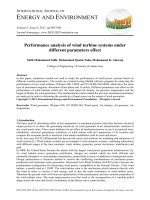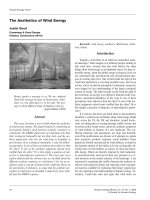Geology of wind cave
Bạn đang xem bản rút gọn của tài liệu. Xem và tải ngay bản đầy đủ của tài liệu tại đây (2.39 MB, 21 trang )
Geolog
y
The
Of Wind Cave
As humans, we are constantly trying to understand
the world around us. Wind Cave is one of many
geological wonders found on the Earth.
The passages
of Wind Cave
are found within
the Pahasapa
Limestone.
Fossils tell us
the origins of
the limestone,
which is a
sedimentary
rock.
The limestone was
created when warm,
shallow seas covered
the land approximately
350 million years ago.
Coral Fossil
When marine
organisms died, their
bodies collected on
the sea floor.
Brachiopod Fossils
With time and
pressure, the
shells and other
sediment were
compacted
together and
solidified, thus
creating the
limestone.
Uplifting pressures in the Black Hills area created
cracks in the limestone.
Acid rich water entered those cracks and began
to dissolve very early cave passageways.
About 65 million years ago, the collision of tectonic
plates west of today’s Black Hills area caused more
buckling and bulging in the earth’s crust.
This uplift created a dome shaped area that
we call the Black Hills today.
That uplifting created more cracks in the limestone. Acid
rich water filled these cracks and began dissolving…
…and enlarging them. As the water table dropped,
the cave passageways...
…and rooms that we see in
Wind Cave today were revealed.
The water that formed the cave began to slowly
drain from the cave about
40 million years ago.
Currently, the water level is about 450 feet below
the surface, an area called the Lakes.
Geologists believe that the unique formation found in
Wind Cave called boxwork, predates the cave.
Internal
pressures
cracked the
limestone.
These
cracks were
later filled
with calcite.
Over time, the boxwork
was exposed as the
more easily dissolved
surrounding limestone
weathered away.
While boxwork is abundant in Wind Cave,
it is rarely found in other caves.
Besides the
unusual
boxwork
formation,
Wind Cave is
also one of
the longest
and most
complex
caves in the
world!
Map of Wind Cave Passages.
Over 124 miles long.
Over the years,
Wind Cave has
undergone many
geological
changes;
however, water
continues to
seep into the
cave. As it does,
the water leaves
behind
formations such
as popcorn and
frostwork.
As the processes shaping the cave continue, we also
continue our quest to understand the vast, incredible
world beneath our feet.









